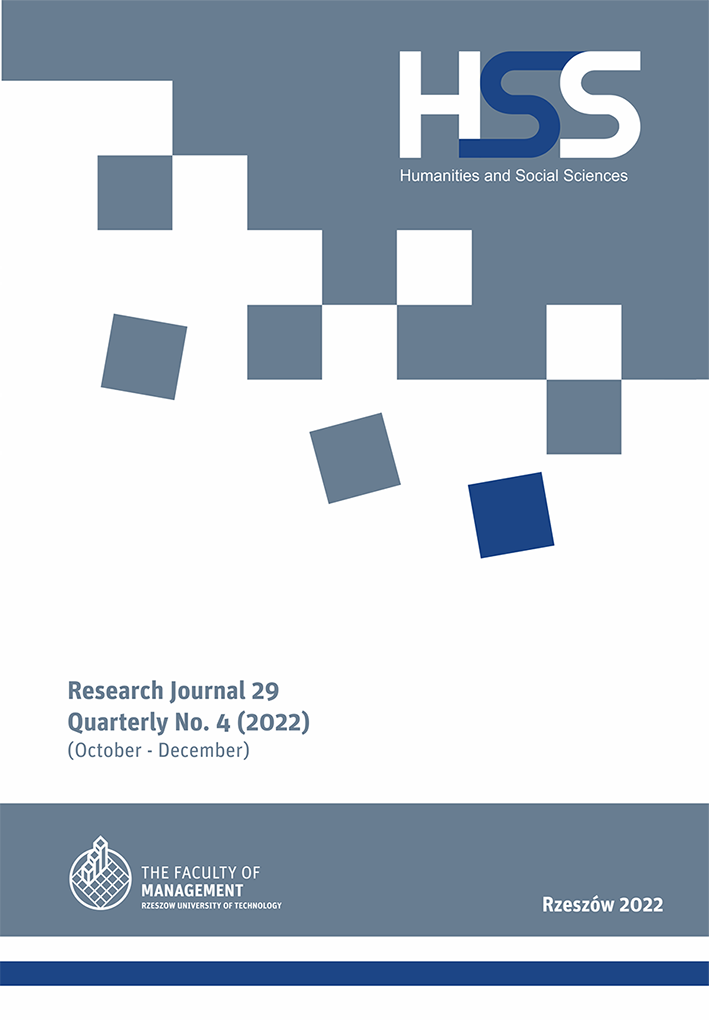Abstract
This article refers to the results of research that was conducted on the eve of the COVID-19 pandemic in Poland, shortly before the first confirmed laboratory case was registered. The research was carried out with 240 people who dealt daily with youth, including NEETs activation, through work or volunteering in various types of institutions (public, NGO, and private). The results allowed us to back upthe hypothesis that people who deal with NEET youth support on a daily basis value traditional methods of professional activation more than digital methods. The analysis also answered the question of which demo-social variables among the respondents had an impact on their assessment of the methods used for professional activation. The variables that were found to significantly differentiate the respondents’ assessments included gender, education, place of residence, the type of institution in which the respondents worked, and the age range of the respondents.
References
Alonso, C.P., Sánchez, P.M., Martínez, A.I. (2022). Is there a uniform NEET identity in the European Union? “International Journal of Adolescence and Youth” 27:1. DOI: 10.1080/02673843.2022.2065922.
Assmann, M.L., Broschinski, S. (2021). Mapping Young NEETs Across Europe: Exploring the Institutional Configurations Promoting Youth Disengagement from Education and Employment. “JAYS” 4. DOI: 10.1007/s43151-021-00040-w.
Bacher, J., Koblbauer, C., Heinz. L., Tamesberger, D. (2017). Small differences matter: How regional distinctions in educational and labour market policy account for heterogeneity in NEET rates. “Journal of Labour Market Research” 51(4). DOI: 10.1186/s12651-017-0232-6.
Council of the European Union, Council Recommendation of 22 April 2013 on Establishing a Youth Guarantee (2013/C 120/01).
Grimaldi, E., Ball, S. (2019). The blended learner: digitalization and regulated freedom – neoliberalism in the classroom. “Journal of Education Policy” 36. DOI: 10.1080/02680939.2019.1704066.
Hardy, W., Kalinowski, H., Palczyńska, M., Smoter, M. (2018). Badanie efektów wsparcia zrealizowanego na rzecz osób młodych w ramach Programu Operacyjnego Wiedza Edukacja Rozwój – II Raport tematyczny. Ministerstwo Rozwoju, Pracy i Technologii. Access on the internet: https://www.ewaluacja.gov.pl/media/75441/II_Raport-tematyczny.pdf.
Kraatz, S. (2018). Digital technology in the delivery of PES services. “Workshop report for XI WAPES World Congress” 19–20.04.2018, Marrakech.
—— (2021). Active support for the unemployed: implications of digitalisation for professionalism in career guidance [in:] Cedefop et al., Digital transitions in lifelong guidance: rethinking careers practitioner professionalism: a CareersNet expert collection. Luxembourg: Publications Office. Cedefop working paper; No 2. DOI: 10.2801/539512.
Liszka, D., Walawender, P. (2018). NEET Youth – the concept’s presence in the European Union’s Youth employment policy and why it is so problematic. “Humanities and Social Sciences” 4 (23). DOI: 10.7862/rz.2018.hss.77.
—— (2021). Cooperation towards supporting dual education systems (vocational education). “Humanities and Social Sciences” 2 (28). DOI: 10.7862/rz.2021.hss.14.
Madej-Kurzawa, I., Pieczarka, K., Węgrzyn, G. (2021). Professional and educational activity of youth in the digital economy. “Problems and Perspectives in Management” 19. DOI: 10.21511/ppm.19(3).2021.15.
Mascherini, M., Salvatore, L., Meierkord, A.K., Jungblut, J.-M. (2012). NEETs: Young people not in employment, education or training – Characteristics, costs and policy responses in Europe. Luxembourg: Publications Office of the European Union. DOI: 10.2806/41578.
Mirończuk, J. (2014). NEET – zjawisko i problem społeczno-ekonomiczny w Unii Europejskiej. „Przegląd Zachodniopomorski” 3(1).
OECD (2016). The NEET challenge: What can be done for jobless and disengaged youth? [in:] Society at a Glance 2016: OECD Social Indicators. Paris: OECD Publishing. DOI: 10.1787/soc_glance-2016-4-en.
Parrag, P. (2019). The Hungarian Youth Guarantee System and the NEET (Not in Employment, Education or Training): Hope or Despair. BA/BSc thesis. BCE Társadalomtudományi és Nemzetközi Kapcsolatok Kar, Szociológia és Társadalompolitika Intézet. Access on the internet: http://publikaciok.lib.uni-corvinus.hu/publikus/szd/Parrag_Petra.pdf.
Rak, A.M. (2022). Determinants of NEET (not in employment, education or training) on the Polish labour market. “Zeszyty Naukowe UPH, Seria Administracja i Zarządzanie”, 56(129). DOI: 10.34739/zn.2021.56.03.
Scarano, G., Colfer, B. (2022). Linking active labour market policies to digitalisation–a review between remote and automated possibilities. “International Journal of Sociology and Social Policy”. DOI: 10.1108/IJSSP-02-2022-0050.
Smoter, M. (2022). Outreach Practices of Public Employment Services Targeted at NEET Youth in Poland. “Youth & Society” 54(2_suppl). DOI: 10.1177/0044118X211058224.
Strecker, T., López, J., Cabasés, M.À. (2021). Examining NEET situations in Spain: Labour Market, Discourses and Policies. “JAYS” 4. DOI: 10.1007/s43151-021-00048-2.
Szpakowicz, D. (2022). Problematizing engagement with technologies in transitions of young people identified as ‘Not in Education, Employment or Training’ (NEET) in Scotland. “Journal of Youth Studies”. DOI: 10.1080/13676261.2022.2080538.
Tosun, J. (2017). Promoting youth employment through multi-organizational governance. “Public Money and Management” 37(1). DOI: 10.1080/09540962.2016.1249230.
wapteka (2020). Chiński Wirus. Jakie są objawy chińskiego koronawirusa? [Access: 12.08.2022]. Access on the internet: https://www.wapteka.pl/blog/artykul/chinski-wirusjakie-sa-objawy-chinskiego-koronawirusa.


